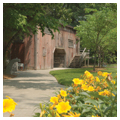In 1913 Paul Pfeiffer, who had made his fortune in the pharmaceutical business in St. Louis, moved with his wife, Mary, and their children to Piggott. A few years previously he had recognized the agricultural potential of northeast Arkansas and begun buying land here, eventually accumulating 63,000 acres. The Pfeiffers purchased this house from local contractor W. D. Templeton, who had built it for his family from a design in a pattern book. The large but unassuming two-story Colonial Revival house is built of wood, has a deep single-story front porch that wraps around the southeast corner, a gabled bay, a pedimented dormer window, and a rear kitchen wing. Since Piggott did not have a Catholic church, a chapel for Mary Pfeiffer and a visiting priest was incorporated into the center of the house.
In 1925, the Pfeiffers’ daughter, journalist Pauline, met novelist Ernest Hemingway in Paris while she was on a work assignment for Vogue magazine. Following Hemingway’s divorce from his first wife, he and Pauline married in 1927, and during their thirteen years together they visited Piggott frequently. In order to give Hemingway a quiet place to write, the Pfeiffers converted the upper story of a wooden carriage house (known as the barn) on their property. The structure is built of vertical cypress boards, and its upper story originally was a hay loft. During his visits here, Hemingway wrote parts of A Farewell to Arms and several short stories.
In 1997, Arkansas State University (A-State) acquired the house and barn from its owner, Beatrice Janes. Development of the Hemingway-Pfeiffer Museum and Educational Center was A-State’s first Heritage Sites project (see CG6). A-State restored the house and the barn to their condition in the 1920s and 1930s, allowing visitors to experience the lifestyle of an upper-class rural home of the 1930s in the Arkansas Delta and the time period when Hemingway and Pauline Pfeiffer stayed here. The museum contains memorabilia of Hemingway’s occupancy in addition to original furnishings.


















